2019 年 12 月英语六级真题及答案第二套
Writing
(30 minutes)
Listening Comprehension
Part I
Directions: For this part you are allowed 30 minutes to write an essay on the importance of
havingasenseofsocialresponsibility.Youshouldwriteatleast150wordsbutnomorethan
200 words.
Part II
Section A
Directions:In this section, you will hear two long conversations. At the end of
eachconversation,youwillhearfourquestions.Boththeconversationandthequestionswill
bespokenonlyonce.Afteryouhearaquestion,youmustchoosethebestanswerfromthefour
choices marked A), B), C),and D). Then mark the corresponding letter on Answer Sheet 1 with
a single line through the centre.
Questions 1 to 4 are based on the conversation you have just heard.
1. A) It focuses exclusively on jazz.
(30 minutes)
C) It has several branches in London.
talents.
2.A) It originated with cowboys.
C) Its listeners are mostly young people.
music.
3.A) Its definition is varied and complicated.
experimentation.
B) It sponsors major jazz concerts.
D) It displays albums by new music
B) Its market has now shrunk.
D) It remains as widespread as hip hop
B)
It
is
still
going
through
C) It is frequently accompanied by singing.
D) Its style has remained largely
unchanged.
4.A) Learn to play them.
B) Take music lessons.
C) Listen to them yourself.
D) Consul jazz musicians.
Questions 5 to 8 are based on the conversation you have just heard.
5. A) She paid her mortgage.
B) She called on the man.
C) She made a business plan.
D) She went to the bank.
6. A) Her previous debt hadn’t been cleared yet.
considered poor.
B)
Her
credit
history
was
C) She had apparently asked for too much.
7. A) Pay a debt long overdue.
C) Start her own business.
D) She didn’t pay her mortgage in time.
B) Buy a piece of property.
D) Check her credit history.
8. A) Seek advice from an expert about fundraising. B) Ask for smaller loans from different
lenders.
C) Build up her own finances step by step.
D)
Revise
her
business
proposal
carefully.
Section B
Directions:Inthissection,youwillheartwopassages.Attheendofeachpassage,youwill
hear three or four questions. Both the passage and the questions will be spoken only once.
After you hear a question, you must choose the best answer from the four choices marked A),
B),C)andD).ThenmarkthecorrespondingletteronAnswerSheet1withasinglelinethrough
the centre.
�
Questions 9 to 11 are based on the passage you have just heard.
9.A) It is profitable and environmentally friendly. B) It is well located and completely
automated.
C) It is small and unconventional.
10.A) Their urge to make farming more enjoyable.
equipment.
D) It is fertile and productive.
B) Their desire to improve farming
C) Their hope to revitalize traditional farming. D) Their wish to set a new farming
standard.
11.A) It saves a lot of electricity.
C) It causes hardly any pollution.
B) It needs little maintenance.
D) It loosens soil while weeding.
Questions 12 to 15 are based on the passage you have just heard.
12.A) It has turned certain insects into a new food source.
B) It has started on expand business outside the UK.
C) It has imported some exotic foods from overseas.
D) It has joined hands with Sainsbury’s to sell pet insects.
13.A) It was really unforgettable.
C) It hurts his throat slightly.
B) It was a pleasant surprise.
D) It made him feel strange.
14.A) They are more tasty than beef,chicken or pork.
B) They are more nutritious than soups and salads.
C) They contain more protein than conventional meats.
D) They will soon gain popularity throughout the world.
15.A) It is environmentally friendly.
B) It is a promising industry.
C) It requires new technology.
D) It saves huge amount of labor.
Section C
Directions: Inthissection,youwillhearthreerecordingsoflecturesortalksfollowedby
threeorfourquestions.Therecordingswillbeplayedonlyonce.Afteryouhearaquestion,
youmustchoosethebestanswerfromthefourchoicesmarkedA),B),C)andD).Thenmarkthe
corresponding letter on Answer Sheet 1 with a single line through the centre.
Questions 16 to 18 are based on the recording you have just heard.
16.A) To categorize different types of learners.
B) To find out what students prefer to learn.
C) To understand the mechanism of the human brain.
D) To see if they are inherent traits affecting learning.
17.A) It was defective.
C) It was original in design.
B) It was misguided.
D) It was thought-provoking.
18.A) Auditory aids are as important as visual aids.
B) Visual aids are helpful to all types of learners.
C) Reading plain texts is more effective than viewing pictures.
D) Scientific concepts are hard to understand without visual aids.
Questions 19 to 22 are based on the recording you have just heard.
19.A) Not playing a role in a workplace revolution.
B) Not benefiting from free-market capitalism.
C) Not earning enough money to provide for the family.
D) Not spending enough time on family life and leisure.
�
20.A) People would be working only fifteen hours a week now.
B) The balance of power in the workplace would change.
C) Technological advances would create many new jobs.
D) Most workers could afford to have house of their own.
21.A) Loss of workers’ personal dignity.
C) Deterioration of workers’ mental health.
B) Deprivation of workers’ creativity.
D) Unequal distribution of working
hours.
Questions 22 to 25 are based on the recording you have just heard.
22.A) It is the worst managed airport in German history.
B) It is now the biggest and busiest airport in Europe.
C) It has become something of a joke among Germans.
D) It has become a typical symbol of German efficiency.
23.A) The city’s airports are outdated.
C) The city wanted to boost its economy.
B) The city had just been reunified.
D) The city wanted to attract more
tourists.
24.A) The municipal government kept changing hands.
B) The construction firm breached the contract.
C) Shortage of funding delayed its construction.
D) Problems of different kinds kept popping up.
25.A) Tourism industry in Berlin suffers.
C) Huge maintenance costs accumulate.
B) All kinds of equipment gets rusted.
residents
D)
Complaints
local
by
Reading Comprehension
increase.
Part III
Section A
Directions:In this section, there is a passage with ten blanks. You are required to select
one word for each blank from a list of choices given in a word bank following the passage.
Read the passage through carefully before making your choices. Each choice in the bank is
identified by a letter. Please mark the corresponding letter for each item on Answer Sheet
2 with a single line through the centre. You may not use any of the words in the bank more
than once.
(40 minutes)
The persistent haze over many of our cities is a reminder of the polluted air that we breathe.
Over 80% of the world’s urban population is breathing air that fails to meet World Health
Organization guidelines, and an estimated 4.5 million people died
from outdoor air
pollution in 2015.
26
Globally, urban populations are expected to double in the next 40 years. An extra 2 billion
people will need new places to live, services and ways to move around their cities. What is
more important, the decisions that we make now about the design of our cities will 27
the
everyday lives and health of the coming generations. So what would the components of a smog-free,
or at least low-pollution, city be like?
Traffic has become
with air pollution, and many countries intend to ban the sale of
new petrol and diesel cars in the next two decades. But simply
to electric cars will not
mean pollution-free cities. The level of emissions they cause will depend on how the electricity
to run them is
as they wear
out.
, while brakes, tyres and roads all create tiny airborne
29
31
28
30
�
Across the developed world, car use is in decline as more people move to city centers, while
for other means of travel. Researchers are already asking
young people especially are 32
and will decline, but transport planners have yet
if motor vehicle use has reached its
, instead laying new roads to tackle traffic jams.As users of
to catch up with this
London’s orbital M25 motorway will know, new roads rapidly fill with more traffic. In the
US, studies have shown that doubling the size of a road can
double the traffic, taking
us back to the starting point.
33
35
34
A) alternateF) mergedK) prematurely
B) crownG) miniatures
C) determineH) optingM) switching
D) generatedI) particlesN) synonymous
E) locating
L) simply
J) peakO) trend
Section B
Directions:In thissection, you are going to read a passagewith ten statements attached to
it.Eachstatementcontainsinformationgiveninoneoftheparagraphs.Identifytheparagraph
fromwhichtheinformationisderived.Youmaychooseaparagraphmorethanonce.Eachparagraph
is marked with a letter. Answer the question by marking the corresponding letter on Answer
Sheet 2.
How Much Protein Do You Really Need?
[A] The marketing is tempting: Get stronger muscles and healthier bodies with minimal effort
by adding protein powder to your morning shake or juice drink. Or grab a protein bar at lunch
or for a quick snack. Today, you can find protein supplements everywhere—online or at the
pharmacy, grocery store or health food store. They come in powders, pills and bars.With more
than $12 billion in sales this year, the industry is booming and, according to the market
research company, Grand View Research, is on track to sell billions more by 2025. But do we
really need all this supplemental protein? It depends. There are pros, cons and some ho-hums
to consider.
[B] For starters, protein is critical for every cell in our body. It helps build nails, hair,
bones and muscles. It can also help you feel fuller longer than eating foods without protein.
And, unlike nutrients that are found only in a few foods, protein is present in all foods.
“The typical American diet is a lot higher in protein than a lot of us think,” says registered
dietitian Angela Pipitone. “It’s in foods many of us expect, such as beef, chicken and other
types of meat and dairy. But it’s also in foods that may not come immediately to mind like
vegetables, fruit, beans and grains.”
[C] The U.S. government’s recommended daily allowance (RDA) for the average adult is 50 to
60 grams of protein a day. This may sound like a lot, but Pipitone says: “We get bits of protein
here and there and that really adds up throughout the day.”Take, for example, breakfast. If
you ate two eggs topped with a little bit of cheese and an orange on the side, you already
have 22 grams of protein. Each egg gives you 7 grams, the cheese gives you about 6 grams and
the orange—about 2 grams. Add a lunch of chicken, rice and broccoli, and you are already over
the recommended 50 grams. “You can get enough protein and meet the RDA before you even get
to dinner,” says Pipitone.
[D] So if it’s so easy to get your protein in food, why add more in the form of powders, snack
�
bars or a boost at your local juice bar? No need to, says Pipitone because, in fact, most of
us already get enough protein in our diet.“Whole foods are always the best option rather than
adding supplements,” she says, noting the FDA does not regulate supplements as rigorously
as foods or drugs.So there could be less protein, more sugar and some additives you wouldn’t
expect, such as caffeine.
[E] If you are considering a supplement, read the list of ingredients, she says, although this
is not always reliable. “I’ve seen very expensive protein supplements that claim to be high
quality but they might not really be beneficial for the average healthy adult,” she says.
“It could just be a waste of money.”
[F] But there are certain situations that do warrant extra protein. “Anytime you’re repairing
or building muscle,” Pipitone says, such as if you’re an extreme endurance athlete, training
for a marathon, or you’re a body builder.If you’re moderately exercising for 150 minutes
a week, as the Centers for Disease Control and Prevention recommends, or less than that, you’re
probably not an extreme athlete.Extreme athletes expend lots of energy breaking down and
repairing and building muscles. Protein can give them the edge they need to speed that process.
[G] Vegans can benefit from protein supplements since they do not eat animal-based protein
sources like meat, dairy or eggs. And, for someone always on-the-go who may not have time for
a meal, a protein snack bar can be a good option for occasional meal replacement.Also,
individuals recovering from surgery or an injury can also benefit from extra protein. So, too,
can older people. At around age 60, “muscles really start to break down,” says Kathryn Starr,
an aging researcher, “and because of that, the protein needs of an older adult actually
increases.”
[H] In fact, along with her colleague Connie Bales, Starr recently conducted a small study
that found that adding extra protein foods to the diet of obese older individuals who were
trying to lose weight strengthened their muscles. Participants in the study were separated
into two groups—one group was asked to eat 30 grams of protein per meal in the form of whole
foods. That meant they were eating 90 grams of protein a day. The other group—the control
group—was put on a typical low-calorie diet with about 50 to 60 grams of protein a day.After
six months, researchers found the high protein group had significantly improved their muscle
function—almost twice as much as the control group.“They were able to walk faster, had
improved balance, and were also able to get up out of a chair faster than the control group,”
Starr says.All 67 participants were over 60 years of age, and both groups lost about the same
amount of weight.
[I] Starr is now looking into whether high-protein diets also improve the quality of the muscle
itself in seniors. She’s using CT scans to measure muscle size and fat, and comparing seniors
on a high-protein diet to those on regular diets. She says her findings should be available
in a couple of months.
[J] In the meantime, 70-year-old Corliss Keith, who was in the high protein group in Starr’s
latest study, says she feels a big difference. “I feel excellent,” she says. “I feel like
I have a different body, I have more energy, I’m stronger.” She says she is able to take
Zumba exercise classes three times a week, work out on the treadmill, and take long, brisk
walks. Keith also lost more than 15 pounds. “I’m a fashionable person, so now I’m back in
my 3-inch heels,” she says.
[K] As people age, Starr says muscle strength is key to helping them stay strong and continue
�
living on their own in their own home. “I feel very much alive now,” says Keith. “I feel
like I could stay by myself until I’m 100.”
[L] But can people overdo protein? Pipitone says you do have to be careful. Other researchers
say too much protein can cause nausea, headaches, and fatigue.Dehydration is also a risk when
you eat too much protein. Pipitone says if you increase protein, you also have to increase
your fluid intake. “I always tell people to make sure they’re drinking enough fluids,” which
for the average person is 60 to 70 ounces a day, which translates into eight 8-ounce glasses
of water or liquid per day.
[M] There have been some indications that extra protein makes the kidneys work harder, which
could be problematic for individuals with a history of kidney disease and for them, the
supplements may increase the risk of kidney stones, she says.
[N] Bottom line, if you think you need more protein in your diet, consider these questions:
Are you are an extreme athlete; are you recovering from injury or surgery; or are you 60 years
or older?If so, adding high protein foods like eggs and meat products to your diet can be
beneficial.And, if you’re not sure, it is always a good idea to check with your primary care
provider.
36. It is quite easy for one to take in the recommended amount of protein.
37. Pipitone claims that healthy adults need not spend money on protein supplements.
38. The protein supplement business is found to be thriving.
39. Protein can speed the repairing of damaged muscles.
40. Protein supplements may overburden some internal organ, thus leading to its malfunctioning.
41. Older adults need to take in more protein to keep their muscles strong.
42. Protein is found in more foods than people might realize.
43. Additional protein was found to help strengthen the muscles of overweight seniors seeking
weight loss.
44. Pipitone believes that whole foods provide the best source of protein.
45. People are advised to drink more liquid when they take in more protein.
Section C
Directions:There are2 passagesin thissection.Eachpassage is followed bysomequestions
or unfinished statements. For each of them there are four choices marked A), B), C) and D).
YoushoulddecideonthebestchoiceandmarkthecorrespondingletteronAnswerSheet2with
a single line through the centre.
Passage One
Questions 46 to 50 are based on the following passage.
Last year, a child was born at ahospital in the UK with her heart outside her body. Few
babies survive this rare condition, and those who do must endure numerous operations and are
likely to have complex needs.When her mother was interviewed, three weeks after her daughter’s
birth, she was asked if she was prepared for what might be a daunting task caring for her.
She answered without hesitation that, as far as she was concerned, this would be a
“privilege”.
Rarely has there been a better example of the power of attitude, one of our most powerful
psychological tools. Our attitudes allow us to turn mistakes into opportunities, and loss into
�
the chance for new beginnings. An attitude is a settled way of thinking, feeling and/or behaving
towards particular objects, people, events or ideologies. We use our attitudes to filter,
interpret and react to the world around us. You weren’t born with attitudes. They’re all
learned, and this happens in a number of ways.
The most powerful influences occur during early childhood and include both what happened
to you directly, and what those around you did and said in your presence. As you acquire
adistinctive identity, your attitudes are further refined by the behaviors of those with whom
you identify—your family, those of your gender and culture, and the people you admire, even
though you may not know them personally. Friendships and other important relationships become
increasingly important, particularly during adolescence.About that same time and throughout
adulthood, the information you receive, especially when ideas are repeated in association with
goals and achievements you find attractive, also refine your attitudes.
Many people assume that our attitudes are internally consistent, that is, the way you think
and feel about someone or something predicts your behavior towards them. However, many studies
have found that feelings and thoughts don’t necessarily predict behavior.In general, your
attitudes will be internally consistent only when the behavior is easy, and when those around
you hold similar beliefs. That’s why, for example, many say they believe in the benefits of
recycling or exercise, but don’t behave in line with their views, because it takes awareness,
effort and courage to go beyond merely stating you believe something is a good idea.
One of the most effective ways to change an attitude is to start behaving as if you already
feel and think the way you’d prefer to. Take some time to reflect on your attitudes, to think
about what you believe and why. Is there anything you consider a burden rather than a privilege?
If so, start behaving—right now—as if that is the case.
46. What do we learn from the passage about attitude?
A) It shapes our beliefs and ideologies.
B) It improves our psychological wellbeing.
C) It determines how we respond to our immediate environment.
D) It changes the way we think, feel and interact with one another.
47. What can contribute to the refinement of one’s attitude, according to the passage?
A) Their idols’ behaviors.
C) Their contact with the opposite gender.
B) Their educational level.
D) Their interaction with different
cultures.
48. What do many studies find about people’s feelings and thoughts?
A) They may not suggest how a person is going to behave.
B) They are in a way consistent with a person s mentality.
C) They may not find expression in interpersonal relations.
D) They are in line with a person’s behavior no matter what.
49. How come many people don’t do what they believe is good?
A) They can’t afford the time.
C) They are hypocritical.
B) They have no idea how to.
D) They lack willpower.
50. What is proposed as a strategy to change attitude?
A) Changing things that require one s immediate attention.
B) Starting to act in a way that embodies one’s aspirations.
C) Adjusting one’s behavior gradually over a period of time.
�
D) Considering ways of reducing one’s psychological burdens.
Passage Two
Questions 51 to 55 are based on the following passage.
Industrial fishing for krill in the unspoiled waters around Antarctica is threatening the
future of one of the world’s last great wildernesses, according to a new report.
The study by Greenpeace analyzed the movements of krill fishing vessels in the region and
found they were increasingly operating “in the immediate vicinity of penguin colonies and
whale feeding grounds”.It also highlights incidents of fishing boats being involved in
groundings, oil spills and accidents, which it said posed a serious threat to the Antarctic
ecosystem.
The report, published on Tuesday, comes amid growing concern about the impact of fishing
and climate change on the Antarctic. A global campaign has been launched to create a network
of ocean sanctuaries to protect the seas in the region and Greenpeace is calling for an immediate
halt to fishing in areas being considered for sanctuary status.
Frida Bengtsson from Greenpeace’s Protect the Antarctic campaign, said: “If the krill
industry wants to show it’s a responsible player, then it should be voluntarily getting out
of any area which is being proposed as an ocean sanctuary, and should instead be backing the
protection of these huge tracts of the Antarctic.”
A global campaign has been launched to turn a huge tract of Antarctic seas into ocean
sanctuaries, protecting wildlife and banning all fishing.One was created in the Ross Sea in
2016, another reserve is being proposed in a vast area of the Weddell Sea, and a third sanctuary
is under consideration in the area west of the Antarctic peninsula—a key krill fishing area.
The Commission for the Conservation of Antarctic Marine Living Resources (CCAMLR)manages
the seas around Antarctica. It will decide on the Weddell Sea sanctuary proposal at a conference
in Australia in October, although a decision on the peninsula sanctuary is not expected until
later.
Keith Reid, a science manager at CCAMLR said the organization sought “a balance between
protection, conservation and sustainable fishing in the Southern Ocean.”He said although more
fishing was taking place nearer penguin colonies it was often happening later in the season
when these colonies were empty.
“The creation of a system of marine protected areas is a key part of ongoing scientific
and policy discussions in CCAMLR,” he added, “Our long-term operation in the region depends
on a healthy and thriving Antarctic marine ecosystem, which is why we have always had an open
dialogue with the environmental NGOs. We strongly intend to continue this dialogue, including
talks with Greenpeace, to discuss improvements based on the latest scientific data. We are
not the ones to decide on establishment of marine protected areas, but we hope to contribute
positively with our knowledge and experience.”
51. What does Greenpeace’s study find about krill fishing?
A) It caused a great many penguins and whales to migrate.
B) It was depriving penguins and whales of their habitats.
C) It was carried out too close to the habitats of penguins and whales.
D) It posed an unprecedented threat to the wildlife around Antarctica.
52. For what purpose has a global campaign been launched?
A) To reduce the impact of climate change on Antarctica.
�
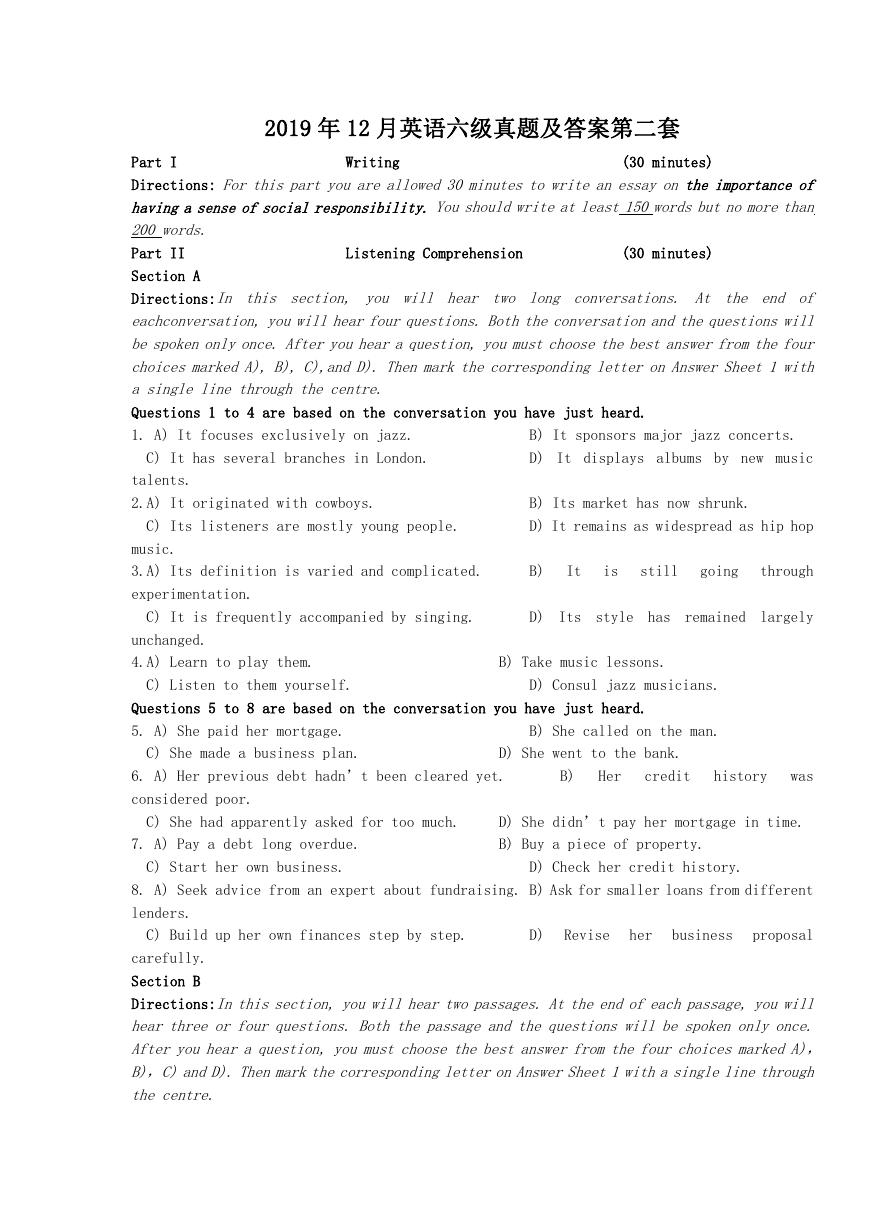
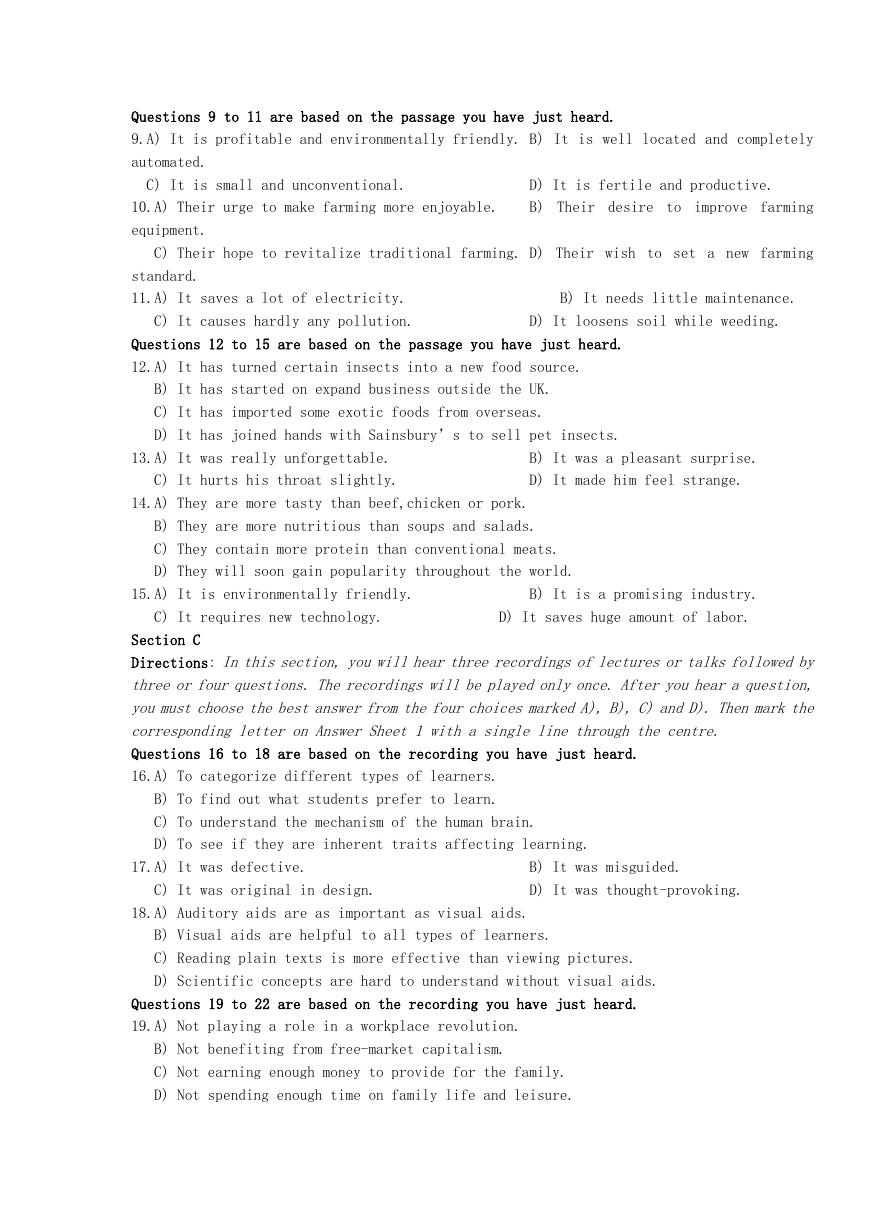
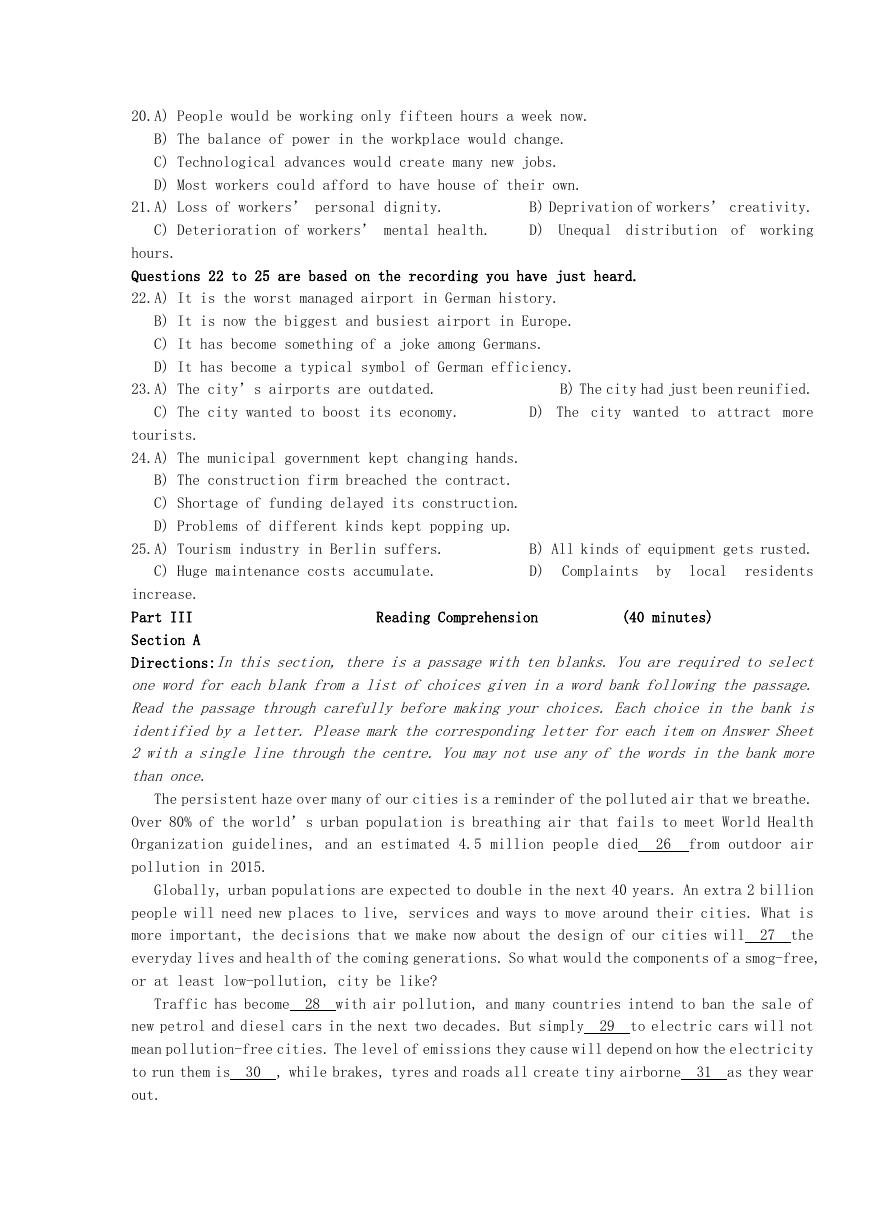
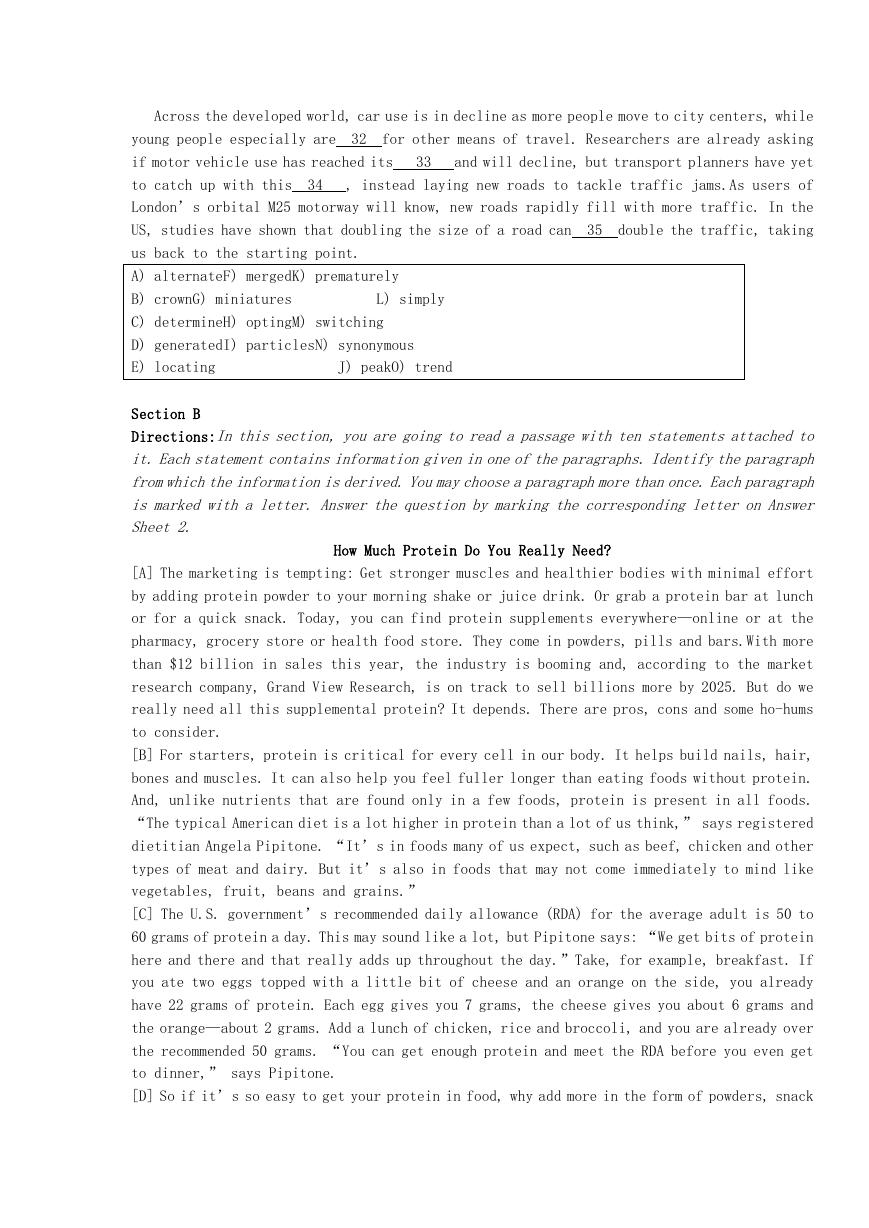
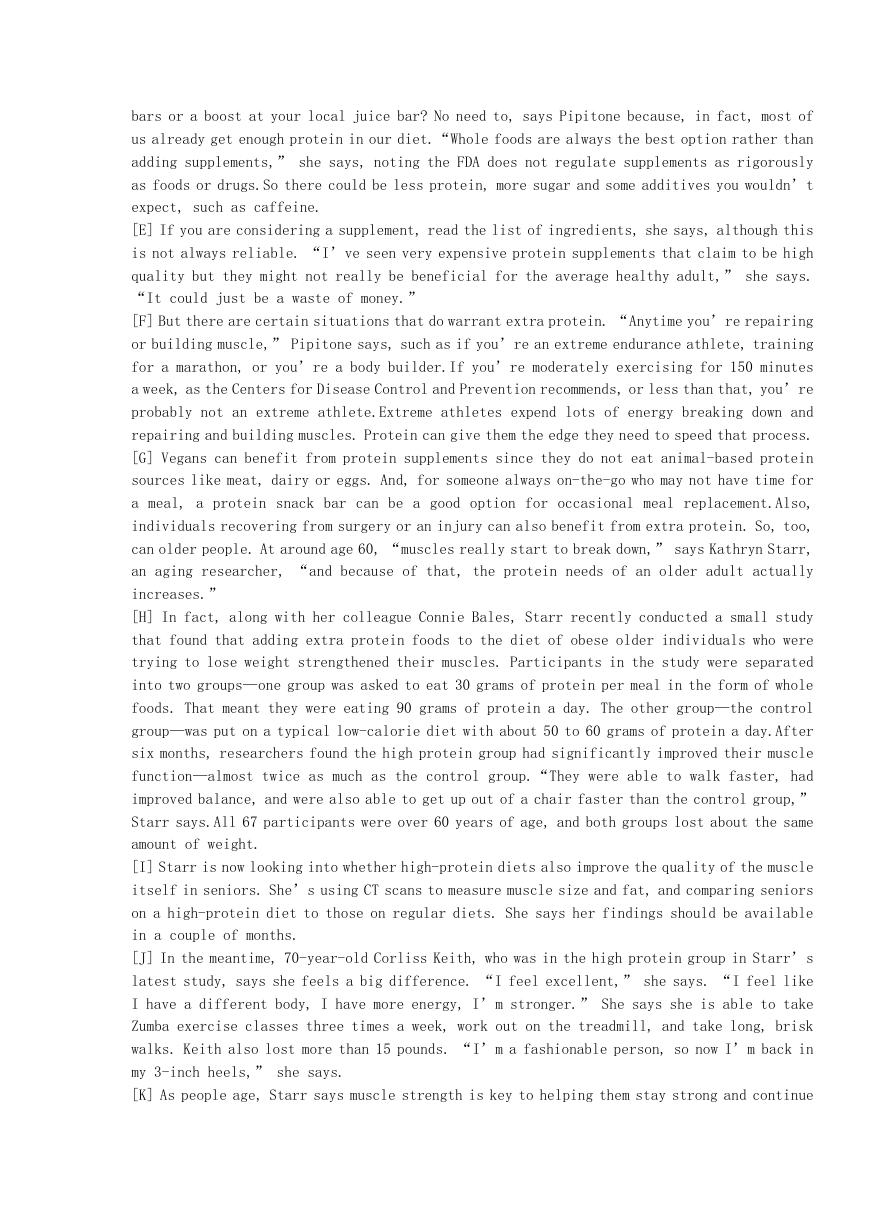
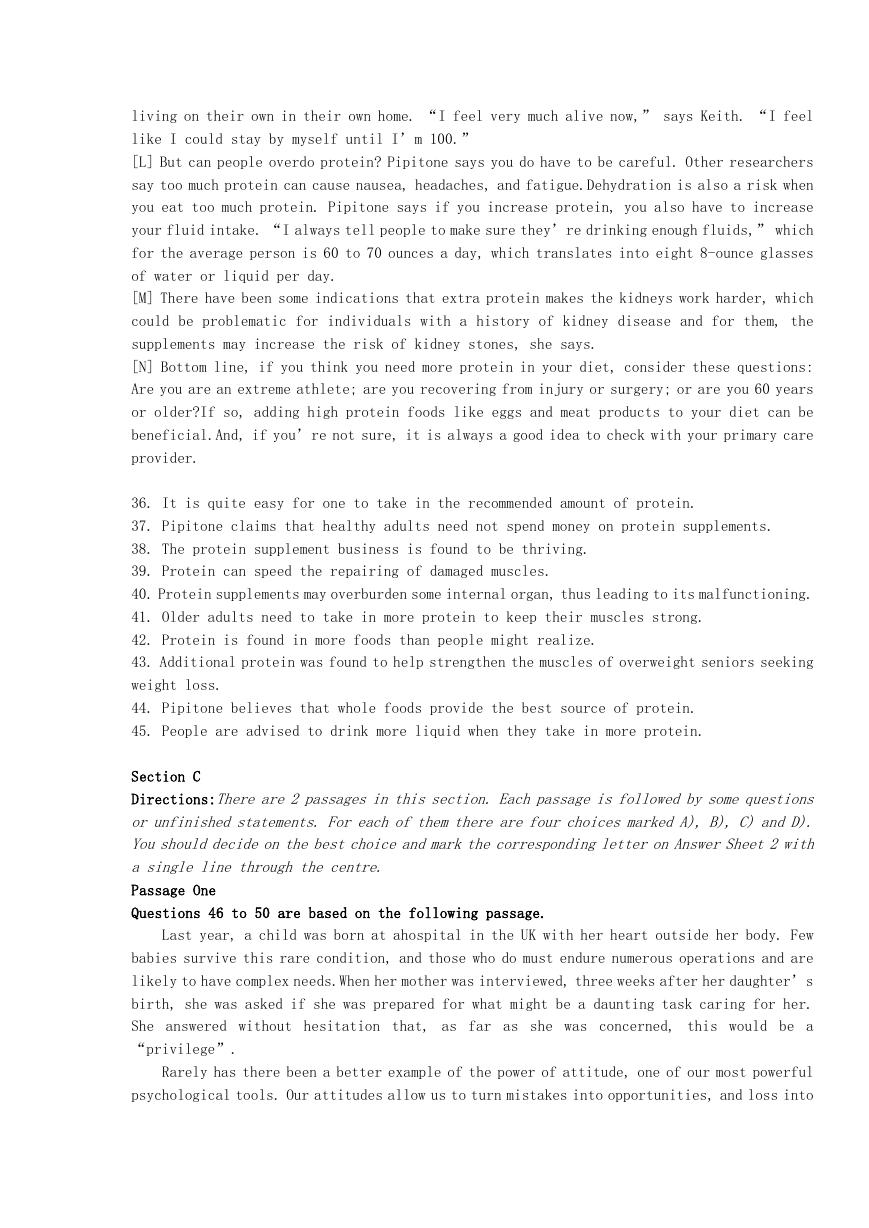










 2023年江西萍乡中考道德与法治真题及答案.doc
2023年江西萍乡中考道德与法治真题及答案.doc 2012年重庆南川中考生物真题及答案.doc
2012年重庆南川中考生物真题及答案.doc 2013年江西师范大学地理学综合及文艺理论基础考研真题.doc
2013年江西师范大学地理学综合及文艺理论基础考研真题.doc 2020年四川甘孜小升初语文真题及答案I卷.doc
2020年四川甘孜小升初语文真题及答案I卷.doc 2020年注册岩土工程师专业基础考试真题及答案.doc
2020年注册岩土工程师专业基础考试真题及答案.doc 2023-2024学年福建省厦门市九年级上学期数学月考试题及答案.doc
2023-2024学年福建省厦门市九年级上学期数学月考试题及答案.doc 2021-2022学年辽宁省沈阳市大东区九年级上学期语文期末试题及答案.doc
2021-2022学年辽宁省沈阳市大东区九年级上学期语文期末试题及答案.doc 2022-2023学年北京东城区初三第一学期物理期末试卷及答案.doc
2022-2023学年北京东城区初三第一学期物理期末试卷及答案.doc 2018上半年江西教师资格初中地理学科知识与教学能力真题及答案.doc
2018上半年江西教师资格初中地理学科知识与教学能力真题及答案.doc 2012年河北国家公务员申论考试真题及答案-省级.doc
2012年河北国家公务员申论考试真题及答案-省级.doc 2020-2021学年江苏省扬州市江都区邵樊片九年级上学期数学第一次质量检测试题及答案.doc
2020-2021学年江苏省扬州市江都区邵樊片九年级上学期数学第一次质量检测试题及答案.doc 2022下半年黑龙江教师资格证中学综合素质真题及答案.doc
2022下半年黑龙江教师资格证中学综合素质真题及答案.doc